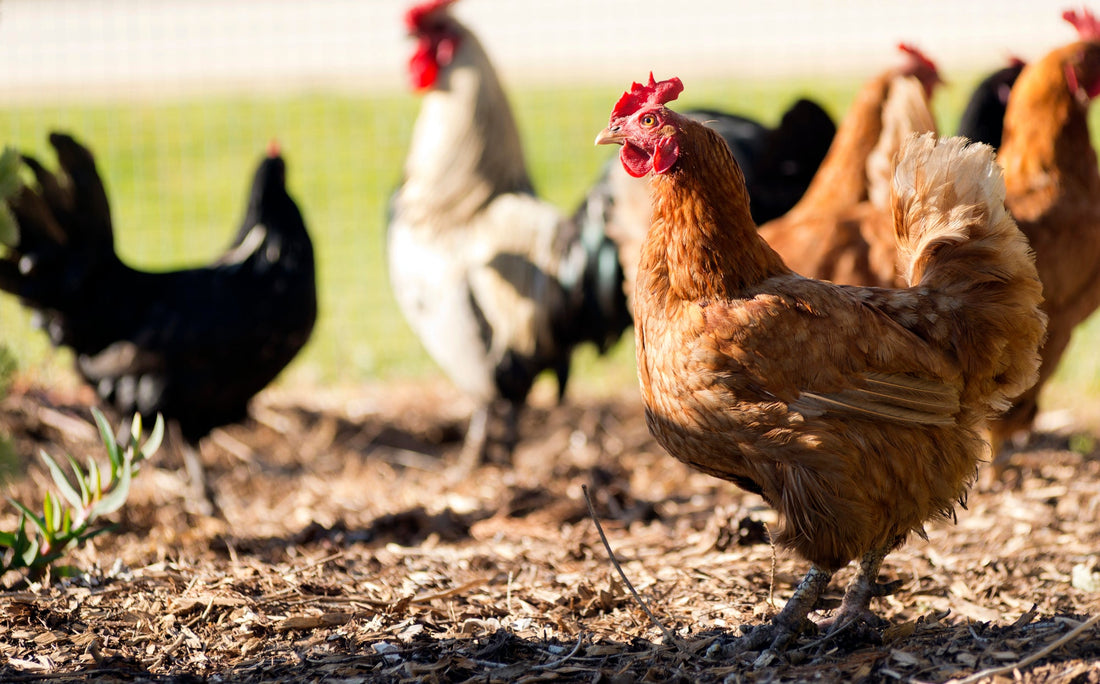Keeping chickens happy and healthy involves regular care, and a monthly health check is an essential part of that routine. A monthly chicken check is an opportunity to assess each bird's physical condition, behavior, and environment to catch any potential health issues early. By performing regular health checks, you can prevent diseases, address health concerns before they escalate, and ensure that your flock remains active, comfortable, and productive. In this guide, we’ll walk through the essential areas to focus on when checking your chickens each month.
Why Regular Health Checks Are Important
Chickens are hardy animals but can be prone to certain health issues, especially if their needs are not regularly monitored. Monthly health checks can help you:
- Detect early signs of illness or injury
- Monitor for parasites like mites and lice
- Ensure they have a healthy diet and body weight
- Evaluate environmental conditions to maintain comfort and cleanliness
By proactively managing your flock’s health, you can prevent small problems from becoming serious issues and maintain a thriving, egg-producing flock.
What to Check During Your Monthly Chicken Health Check
1. General Appearance and Behavior
Begin by observing your chickens’ behavior and overall appearance from a distance. Chickens are creatures of habit, so any changes in behavior can be a clue that something is off.
- Behavior: Look for signs of lethargy, lack of interest in food, or isolation from the flock. Healthy chickens are typically active, alert, and curious.
- Feather Condition: Bright, clean feathers are usually a sign of good health, while dull, patchy, or dirty feathers may indicate stress, parasites, or nutritional deficiencies.
- Stance and Posture: Observe how each chicken stands. A hunched posture, puffed-up feathers, or sitting in the corner may indicate discomfort or illness.
2. Eyes and Beak
Check your chickens’ eyes and beak carefully, as these areas can reveal a lot about their health.
- Eyes: Healthy chickens have clear, bright eyes. Look for any signs of discharge, cloudiness, or swelling, as these can be indicators of respiratory infections or other illnesses.
- Beak: Examine the beak to make sure it is not overgrown, chipped, or cracked. A misshapen or overgrown beak can interfere with eating. You may need to trim the beak carefully if it becomes too long, but this is rare with regular foraging.
3. Comb and Wattles
The comb and wattles are important indicators of your chicken’s health.
- Color and Texture: In a healthy chicken, the comb and wattles are firm, smooth, and vibrant in color (typically red in adult chickens). A pale or shriveled comb may indicate anemia, stress, or illness.
- Temperature Sensitivity: In cold weather, check for signs of frostbite, which can turn the comb and wattles pale or black in spots. In hot weather, ensure they’re not overly swollen or discolored.
4. Skin and Feathers
Inspect the skin and feathers for cleanliness and signs of parasites.
- Feather Quality: Look for missing or broken feathers, which could indicate molting, feather pecking, or an underlying health problem. Chickens naturally molt once a year, usually in fall, and regrow their feathers over several weeks.
- Skin Check: Part the feathers and check the skin for signs of mites or lice, which appear as small, moving specks. The vent area, under the wings, and around the neck are common places where parasites gather.
- Molting or Feather Loss: Molting is normal, but feather loss outside of the molting period may indicate feather pecking, poor diet, or parasite infestations.
5. Vent Area
The vent (the area where chickens lay eggs and pass waste) is a key area to check for cleanliness and health.
- Cleanliness: A healthy vent should be clean, dry, and free of fecal matter or discharge. A dirty or irritated vent can be a sign of digestive problems or a condition like vent gleet, a fungal infection.
- Redness or Swelling: Look for any signs of redness, swelling, or sores around the vent. Any abnormalities should be investigated, as they can indicate reproductive or digestive issues.
6. Legs and Feet
Check your chickens’ legs and feet for injuries, infections, or structural issues.
- Scaly Leg Mites: These mites burrow under the scales on chickens' legs, causing them to lift and look rough. If you see signs of scaly leg mites, treat them promptly with poultry-safe mite treatments or natural remedies like vegetable oil or petroleum jelly.
- Foot Health: Examine the bottom of each foot for signs of cuts, swelling, or bumblefoot (a bacterial infection that causes a hard, swollen lump). Bumblefoot can be painful and requires immediate attention, as it can worsen if untreated.
- Nails and Spurs: While trimming isn’t usually necessary, check that their nails and spurs (for roosters) aren’t overgrown. In some cases, nails can be trimmed if they’re interfering with the bird’s movement.
7. Weight and Body Condition
Gently handle each chicken to feel for their overall weight and body condition.
- Breastbone Check: Feel along the keel bone (breastbone) to check if it’s too prominent. Chickens should have a balance of muscle and fat on either side of the keel. If the breastbone is very pronounced, the chicken may be underweight, which could indicate illness or inadequate nutrition.
- Weight Gain or Loss: Significant weight gain or loss can be a sign of health problems. Take note of any drastic changes and adjust their diet if necessary.
8. Crop Health
The crop is a pouch where chickens temporarily store food before digestion. Check the crop in the evening (when it should be full) and in the morning (when it should be empty).
- Full in the Evening: By the end of the day, the crop should feel full and soft, indicating that the chicken has been eating well.
- Empty in the Morning: The crop should be empty in the morning before they start eating again. A crop that stays full could indicate impacted crop (when the crop becomes blocked) or sour crop (a yeast infection).
9. Egg Laying Consistency (For Laying Hens)
For laying hens, monitor egg production and check for any changes in consistency.
- Frequency of Laying: While egg production naturally declines with age or during molting, a sudden drop in egg-laying can be a sign of stress or illness.
- Eggshell Quality: Look for eggs with thin or brittle shells, as this can indicate a calcium deficiency. Providing free-choice calcium supplements, like crushed oyster shells, can help improve shell quality.
Environmental Check
A monthly health check is also an ideal time to assess your chickens' environment.
1. Coop Cleanliness
Ensure the coop is clean, dry, and free of ammonia odors. Dirty bedding and dampness can lead to respiratory problems, so replace bedding as needed and remove any waste.
2. Perch and Nesting Box Condition
Inspect perches and nesting boxes for cleanliness, and make sure they are in good condition. Replace any damaged or broken parts to avoid injuries.
3. Ventilation and Draft Protection
Good ventilation is essential to reduce moisture and prevent respiratory issues, especially in cold weather. Make sure the coop has proper airflow without exposing chickens to direct drafts.
4. Feed and Water Check
Ensure that feeders and waterers are clean and accessible. Check that your chickens have an adequate supply of fresh water, and refill or clean waterers as needed to prevent contamination.
Additional Tips for a Successful Monthly Check
- Record-Keeping: Keep a log of each monthly health check, noting any concerns or changes in individual birds. This record can help you monitor their health over time and detect patterns.
- Handling with Care: Move slowly and calmly when handling your chickens to avoid stressing them. Chickens are creatures of habit, so gentle handling and a calm approach help them feel comfortable.
- Consult a Vet When Necessary: If you notice any symptoms of illness or injury that you’re unsure how to treat, consult a veterinarian experienced in poultry. Prompt intervention can make a big difference in recovery.
Conclusion
A monthly health check is a simple but powerful way to ensure the well-being of your flock. By observing your chickens’ behavior, examining their physical condition, and checking their environment, you can catch potential issues early and take action before they become serious problems. With regular monitoring and good record-keeping, you’ll have a healthy, productive flock that thrives all year round. Whether you’re a new chicken keeper or an experienced poultry enthusiast, these monthly checks provide peace of mind and the satisfaction of knowing your chickens are in great hands.
FAQs
1. How often should I perform a health check on my chickens?
A thorough health check once a month is recommended, but weekly spot checks can help catch issues early.
2. What are common signs of illness in chickens?
Signs include lethargy, drooping wings, loss of appetite, labored breathing, and changes in behavior or appearance.
3. How do I know if my chicken has mites or lice?
Look for small moving specks around the vent, under the wings, and around the neck. Mites and lice can cause irritation and feather loss.
4. Can I use the same bedding all year round?
Yes, but monitor for mold or dampness. Straw, pine shavings, or hemp bedding are good options, depending on climate and preference.
5. How can I prevent frostbite in winter?
Ensure adequate ventilation, keep the coop dry, and apply petroleum jelly.

